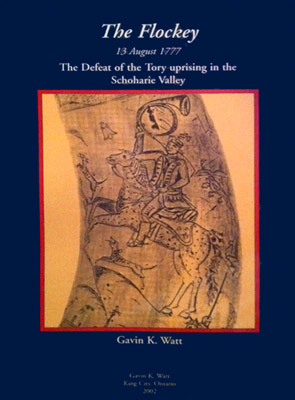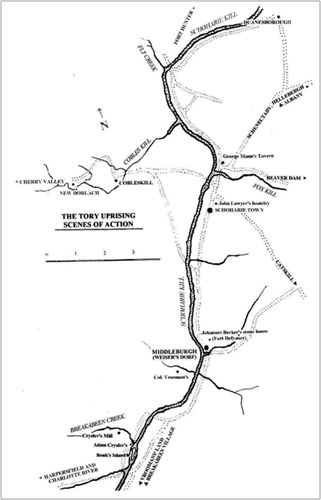The Flockey
 The Flockey, 13 August 1777, The Defeat of the Tory uprising in the Schoharie Valley.
The Flockey, 13 August 1777, The Defeat of the Tory uprising in the Schoharie Valley.
By: Gavin K. Watt
The campaign of 1777 proved to be the turning point of the American Revolution. Two British expeditions invaded upper New York State from Canada. From Montreal, General John Burgoyne's Grand Army of 7,500 British and German Regulars, Tory Provincials, Canadiens and nine hundred Canada and Lakes Indians struck south on Lake Champlain. To everyone's astonishment, the 'impregnable' fortress of Ticonderoga quickly fell to Burgoyne. Then, in rapid order, the United States Army abandoned a series of New York's frontier posts on the Hudson River. Burgoyne seemed poised to take Albany.
While these critical events were underway, a secret network of Mohawk region Tories made an attempt to seize control of the Schoharie Valley.
This book tells how a Troop of the Second Regiment of Continental Light Dragoons defeated the Tories and Indians during the Schoharie Valley uprising in an action known as The Flockey
111 pages. Softcover (perfectbound) 6 X 9. Illustrated, maps, footnotes, index.
Revised edition, Global Heritage Press, Milton 2013 (CD 2013)
ISBN 0-9692366-2-X
Contents include:
- Acknowledgements
- Chapter One - The Rebellion South of the Mohawk
- Chapter Two - The Tories Rise Up
- Epilogue
- Appendices (lists)
- Loyalists with McDonald and Crysler
- Schoharie Indians
- Schoharie Whigs
- Continental Light Dragoons
- The Schoharie Valley and surrounding country
- The Tory Threat to the Schoharie Valley
- The Tory Uprising, Scenes of Action
REVIEWS AND COMMENTS
Terry Holmes, The Bold Highlander.
www.xmarksthescot.com/forum/f98/84th-rof-rhes-my-3-000-post-60521/ (2010)
I don't know if you've ever read them, but if you get a chance find copies of:
Rebellion in the Mohawk Valley: the St. Leger Expedition of 1777
The Flockey: the Defeat of the Tory uprising in the Schoharie Valley and my personal favorite:
The Burning of the Valleys: Daring Raids from Canada against the New York Frontier in the Fall of 1780
All three are authored by Gavin K. Watt, noted Canadian historian of the Loyalist cause, and founder of the BAR's KRRNY.
Their all great, but I really like Burning of the Valleys, almost entirely a Loyalist operation with units such as the King's Yorkers, Butler's Rangers, Brant's Volunteers, the King's Rangers, and the 84th RoF, as well as elements of Jaegers, the 8th (Kings) Regt, etc were all involved. Anyhow, check them out if you can.
– Globalgenealogy.com
Tom Fleming, The American Revolution Round Table (2003)
Tom Fleming reviewed The Flockey by Gavin K. Watt, a Canadian historian who specializes in loyalism in New York state. The book expands a shorter book by John Hayes on an American cavalry attack on a group of loyalists who had laid an ambush in the Flockey, a wetlands in the Scoharie Valley. Watt portrays many other aspects of this loyalist revolt, which was tied into St. Leger's invasion in 1777 and the siege of Fort Stanwix. Tom found the book almost as incoherent as the uprising, with bits of pieces of violence exploding all over the map. Most of the fighting fell to local militia, who were frequently intimidated or outnumbered. Swirling through the chaos was Joseph Brant and his Indian raiders. Eventually, the revolt fizzled, along with St. Leger's siege and Burgoyne's invasion. But it was tumultuous while it lasted, full of vivid confrontations in which neighbors warned neighbors to clear out or else and got warned in return when enough militia from one side or the other were a temporary majority.
Peter W. Johnson, UE. The Loyalist Gazette, UELAC (2002)
As recently as the Fall 2001 Gazette, Gavin Watt's and James Morrison's The British Campaign of 1777 was reviewed. Now, less than a year later, we have an embarrassment of riches
There's a certain sense of dread and doom as one reads through this trilogy, especially the most recent two. It's based on our identification as Loyalist descendants with the hopes and aspirations of those desperate Loyal Americans as the 1777 campaign unfolded. With hindsight, we know that tragedy awaits these people. These are generally not happy stories.
Let's deal with The Flockey first. Certainly everyone's first question is going to concern the book title. The main skirmish in the uprising took place in brush and trees, of the fiat, swampy base below the slope fronting Crysler's. This wetland gave the skirmish its name, the Flockey or "die Flache". (p.82)
 With the hope for success in the Burgoyne campaign in the east, and more especially the expected success of the St. Leger campaign in taking Ft. Stanwix, and then into the Mohawk Valley, the many Loyalists in the Schoharie Valley felt that the time was right to stage their own uprising against the Rebel oppressors. Indeed, Loyalist sentiment in the Valley was so strong, that for a time it appeared this uprising might succeed, but the untimely arrival of Continental Light Dragoons put an end to the Loyalist hopes.
With the hope for success in the Burgoyne campaign in the east, and more especially the expected success of the St. Leger campaign in taking Ft. Stanwix, and then into the Mohawk Valley, the many Loyalists in the Schoharie Valley felt that the time was right to stage their own uprising against the Rebel oppressors. Indeed, Loyalist sentiment in the Valley was so strong, that for a time it appeared this uprising might succeed, but the untimely arrival of Continental Light Dragoons put an end to the Loyalist hopes.
The Flockey is a slim volume, quick reading and dramatic. You will find a number of familiar Loyalist names, and certainly Crysler is one that stands out. Gavin could not fit this event into the two larger books, but he felt that it was incident of such interest and importance, (especially to those with family ties to the area), that it deserved publication. You will agree.
[A] core collection must include Gavin Watt's trilogy: The British Campaign of 1777, The Flockey, and Rebellion In The Mohawk Valley.